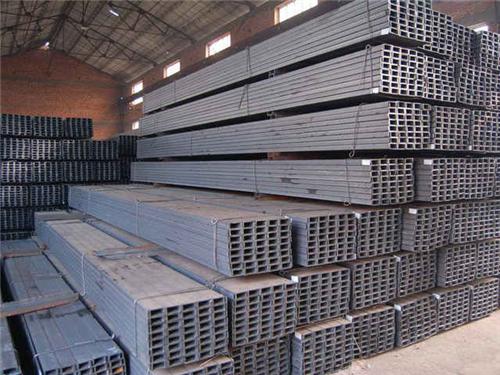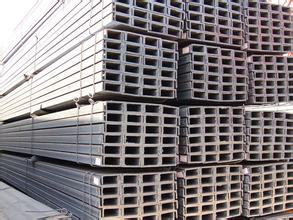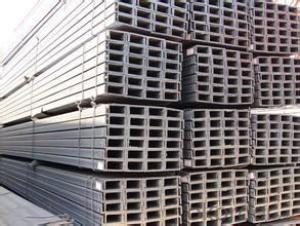Hot Rolled Mild Carbon Structural Steel U-Channel
- Loading Port:
- Qingdao
- Payment Terms:
- TT or LC
- Min Order Qty:
- 2000 PCS
- Supply Capability:
- 40000 PCS/month
OKorder Service Pledge
OKorder Financial Service
You Might Also Like
Hot Rolled Mild Carbon Structural Steel U-Channel
OKorder is offering high quality Hot Rolled Mild Carbon Structural Steel U-Channels at great prices with worldwide shipping. Our supplier is a world-class manufacturer of steel, with our products utilized the world over. OKorder annually supplies products to European, North American and Asian markets. We provide quotations within 24 hours of receiving an inquiry and guarantee competitive prices.
Product Applications:
Hot Rolled Mild Carbon Structural Steel U-Channels are ideal for structural applications and general fabricating.
Product Advantages:
OKorder's Steel Channels are durable, strong, and resists corrosion.
Main Product Features:
· Premium quality
· Prompt delivery & seaworthy packing (7-10 days after receiving deposit)
· Corrosion resistance
· Can be recycled and reused
· Mill test certification
· Professional Service
· Competitive pricing
Product Specifications:
Base Model
Grade: Q195 / Q235 / Q215 / Q345 / SS400 / S235JR, A36, SS400, SS540, ASTM A36
Height: 50 – 400mm
Thickness: 4.5 – 14.5mm
Length: As per customer request
Max Dimensions: 50*37*4.5mm – 400*104*14.5mm
Surface: Painted, galvanized, as per customer request
Punch: Punched as per customer request
Light Model
Grade: Q195 / Q235 / Q215 / Q345 / SS400 / S235JR, A36, SS400, SS540, ASTM A36
Height: 50 – 400mm
Thickness: 4.4 – 8.0mm
Length: As per customer request
Max Dimensions: 50*32*4.4mm – 400*115*8.0mm
Surface: Painted, galvanized, as per customer request
Punch: Punched as per customer request
FAQ:
Q1: Why buy Materials & Equipment from OKorder.com?
A1: All products offered byOKorder.com are carefully selected from China's most reliable manufacturing enterprises. Through its ISO certifications, OKorder.com adheres to the highest standards and a commitment to supply chain safety and customer satisfaction.
Q2: How do we guarantee the quality of our products?
A2: We have established an advanced quality management system which conducts strict quality tests at every step, from raw materials to the final product. At the same time, we provide extensive follow-up service assurances as required.
Q3: How soon can we receive the product after purchase?
A3: Within three days of placing an order, we will begin production. The specific shipping date is dependent upon international and government factors, but is typically 7 to 10 workdays.
Q4: What makes stainless steel stainless?
A4: Stainless steel must contain at least 10.5 % chromium. It is this element that reacts with the oxygen in the air to form a complex chrome-oxide surface layer that is invisible but strong enough to prevent further oxygen from "staining" (rusting) the surface. Higher levels of chromium and the addition of other alloying elements such as nickel and molybdenum enhance this surface layer and improve the corrosion resistance of the stainless material.
Q5: Can stainless steel rust?
A5: Stainless does not "rust" as you think of regular steel rusting with a red oxide on the surface that flakes off. If you see red rust it is probably due to some iron particles that have contaminated the surface of the stainless steel and it is these iron particles that are rusting. Look at the source of the rusting and see if you can remove it from the surface.
Images:




- Q:What are the considerations for constructability and ease of installation with steel I-beams?
- Some considerations for constructability and ease of installation with steel I-beams include the weight and size of the beams, the availability of equipment and machinery to lift and position them, the need for proper alignment and connections, and the potential for on-site modifications or adjustments. Additionally, factors such as site access, temporary support requirements, and coordination with other trades or construction activities also need to be taken into account.
- Q:How do you calculate the load-bearing capacity of a steel I-beam?
- To calculate the load-bearing capacity of a steel I-beam, you need to consider various factors such as the beam's cross-sectional dimensions, material properties, and the type of loading it will be subjected to. The load-bearing capacity can be determined using engineering formulas and calculations, taking into account factors like bending moment, shear force, and deflection. It is essential to consult structural engineering principles and reference codes to accurately determine the load-bearing capacity of a steel I-beam for a specific application.
- Q:How are steel I-beams different from other types of beams?
- Steel I-beams are different from other types of beams primarily because of their shape and the way they distribute weight. Unlike solid rectangular or square beams, I-beams have a distinct "I" shape, with a vertical web and horizontal flanges on either side. This design provides significant strength and structural integrity. One key advantage of steel I-beams is their high strength-to-weight ratio. The vertical web of the I-beam helps to evenly distribute the weight across the entire length of the beam, allowing it to support heavy loads without excessive deflection or bending. This makes them ideal for use in large-scale construction projects, such as skyscrapers, bridges, and industrial buildings. Additionally, the flanges on the I-beam provide resistance against bending and twisting forces, further enhancing its structural stability. This allows for longer spans between support points, reducing the need for additional columns or support structures. Another distinguishing feature of steel I-beams is their versatility. They can be easily fabricated and customized to suit specific project requirements. They are available in various sizes, lengths, and thicknesses, allowing engineers and architects to select the most appropriate beam for their specific application. Furthermore, steel I-beams are highly durable and resistant to deformation, corrosion, and fire. This makes them suitable for use in harsh environments, including marine and industrial settings. Steel I-beams can also be recycled, making them an environmentally friendly choice. In summary, steel I-beams differ from other types of beams due to their distinctive "I" shape, which provides superior strength, weight distribution, and resistance against bending and twisting forces. Their versatility, durability, and recyclability make them a popular choice in a wide range of construction projects.
- Q:What is the theoretical weight per metric ton of 30# I-beam?
- Commonly used hot rolled I-beam specifications are 28# and 32#, 30# is relatively new specifications.
- Q:Can steel I-beams be used for solar panel supports?
- Yes, steel I-beams can be used for solar panel supports. Steel I-beams are a commonly used structural component in construction due to their high strength and durability. They have the ability to bear heavy loads, making them suitable for supporting solar panels. Additionally, steel I-beams can be easily fabricated and installed, making them a cost-effective choice for solar panel mounting systems. The sturdy nature of steel I-beams ensures the stability and longevity of the solar panel installation, even in harsh weather conditions.
- Q:Can Steel I-Beams be used for industrial buildings?
- Yes, Steel I-Beams can be used for industrial buildings. They are commonly used as structural supports due to their high strength-to-weight ratio, durability, and ability to withstand heavy loads.
- Q:What are the common architectural finishes available for steel I-beams?
- Steel I-beams have a variety of architectural finishes to choose from, each with its own benefits and aesthetic qualities. 1. Paint: A popular choice for steel I-beams is painting, which provides a protective coating against corrosion and adds color. It allows for customization with different colors and finishes like gloss, matte, or textured, ensuring it matches the overall design scheme. 2. Galvanizing: Another option is galvanizing, a process that coats steel I-beams with a layer of zinc. This finish offers excellent corrosion resistance, making it suitable for outdoor or high-moisture environments. The appearance can range from shiny to matte, depending on the desired aesthetic. 3. Powder coating: A dry finishing process called powder coating involves electrostatically applying powdered paint to the steel I-beams. The beams are then heated to fuse the powder, resulting in a durable, smooth, and uniform finish. Powder coating provides a wide range of color options and enhanced protection against scratches and fading. 4. Anodizing: Anodizing is commonly used for aluminum I-beams but can also be applied to steel with specific treatments. This finish creates a protective oxide layer on the surface, improving corrosion and wear resistance. Anodized finishes can be clear or colored, offering a sleek and modern appearance. 5. Stainless steel: For a more upscale and contemporary look, stainless steel I-beams are a great choice. They have a naturally shiny and reflective finish, adding elegance to any architectural design. Stainless steel is highly resistant to corrosion, making it suitable for both indoor and outdoor applications. These are just a few of the architectural finishes available for steel I-beams, each with its own advantages in terms of aesthetics, protection, and durability. The choice of finish depends on project requirements, budget, and desired visual impact.
- Q:How do steel I-beams contribute to the overall durability and longevity of a renovation project?
- Steel I-beams contribute to the overall durability and longevity of a renovation project in several ways. Firstly, steel I-beams are known for their exceptional strength and structural integrity. They have a high load-bearing capacity, allowing them to support heavy loads and resist bending or warping. This strength and stability make them ideal for supporting the weight of floors, walls, and roofs in a renovation project, ensuring that the structure remains stable and secure for many years to come. Additionally, steel is highly resistant to many environmental factors that can deteriorate other materials over time. Unlike wood, for example, steel I-beams are not susceptible to rot, termites, or mold, which can compromise the structural integrity and durability of a renovation project. They are also resistant to fire, making them a safer choice in terms of protecting the building and its occupants. Moreover, steel I-beams have a long lifespan and require minimal maintenance. They do not warp or shrink due to moisture or temperature changes, reducing the need for costly repairs or replacements down the line. Steel is also not prone to corrosion when properly coated, ensuring that the I-beams remain strong and durable even in harsh environments. Lastly, steel I-beams offer flexibility in design and construction. Their shape allows for open, spacious interiors without the need for many supporting columns or walls. This flexibility not only enhances the aesthetic appeal of the renovation project but also provides the opportunity for future modifications or additions if needed. In conclusion, steel I-beams contribute significantly to the durability and longevity of a renovation project. Their strength, resistance to environmental factors, long lifespan, low maintenance requirements, and design flexibility make them an ideal choice for supporting structures and ensuring the overall stability and longevity of any renovation project.
- Q:Can steel I-beams be used for wind turbine towers?
- Absolutely! Wind turbine towers can indeed utilize steel I-beams. These I-beams are extensively employed in the construction sector owing to their exceptional robustness and longevity. Their remarkable strength-to-weight ratio renders them ideal for withstanding the weight and impact of wind turbine blades. Moreover, steel is an adaptable material that can be effortlessly shaped and sized to meet the specifications of wind turbine towers. Furthermore, steel I-beams exhibit superior resistance against corrosion, a crucial attribute for structures exposed to the elements. All in all, the structural integrity and dependability of steel I-beams make them an immensely popular choice for wind turbine towers.
- Q:What does "I-beam 125A" mean?
- I-beam, also called steel girder, is a long strip steel with cross section.
1. Manufacturer Overview |
|
|---|---|
| Location | |
| Year Established | |
| Annual Output Value | |
| Main Markets | |
| Company Certifications | |
2. Manufacturer Certificates |
|
|---|---|
| a) Certification Name | |
| Range | |
| Reference | |
| Validity Period | |
3. Manufacturer Capability |
|
|---|---|
| a)Trade Capacity | |
| Nearest Port | |
| Export Percentage | |
| No.of Employees in Trade Department | |
| Language Spoken: | |
| b)Factory Information | |
| Factory Size: | |
| No. of Production Lines | |
| Contract Manufacturing | |
| Product Price Range | |
Send your message to us
Hot Rolled Mild Carbon Structural Steel U-Channel
- Loading Port:
- Qingdao
- Payment Terms:
- TT or LC
- Min Order Qty:
- 2000 PCS
- Supply Capability:
- 40000 PCS/month
OKorder Service Pledge
OKorder Financial Service
Similar products
New products
Hot products
Related keywords






























